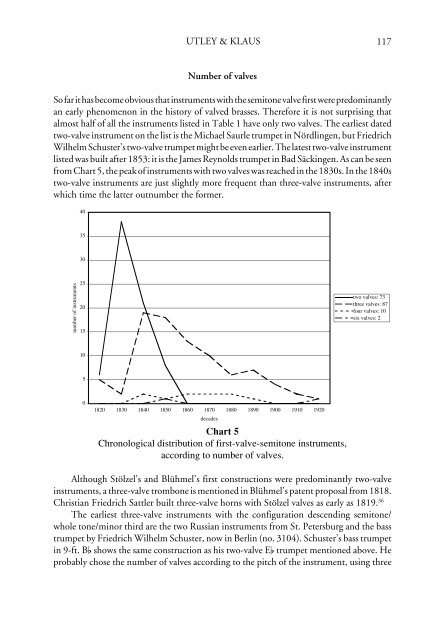Catholic - Historic Brass Society
Catholic - Historic Brass Society
Catholic - Historic Brass Society
Create successful ePaper yourself
Turn your PDF publications into a flip-book with our unique Google optimized e-Paper software.
UTLEY & KLAUS<br />
117<br />
Number of valves<br />
So far it has become obvious that instruments with the semitone valve first were predominantly<br />
an early phenomenon in the history of valved brasses. Therefore it is not surprising that<br />
almost half of all the instruments listed in Table 1 have only two valves. The earliest dated<br />
two-valve instrument on the list is the Michael Saurle trumpet in Nördlingen, but Friedrich<br />
Wilhelm Schuster’s two-valve trumpet might be even earlier. The latest two-valve instrument<br />
listed was built after 1853: it is the James Reynolds trumpet in Bad Säckingen. As can be seen<br />
from Chart 5, the peak of instruments with two valves was reached in the 1830s. In the 1840s<br />
two-valve instruments are just slightly more frequent than three-valve instruments, after<br />
which time the latter outnumber the former.<br />
Chart 5<br />
Chronological distribution of first-valve-semitone instruments,<br />
according to number of valves.<br />
Although Stölzel’s and Blühmel’s first constructions were predominantly two-valve<br />
instruments, a three-valve trombone is mentioned in Blühmel’s patent proposal from 1818.<br />
Christian Friedrich Sattler built three-valve horns with Stölzel valves as early as 1819. 36<br />
The earliest three-valve instruments with the configuration descending semitone/<br />
whole tone/minor third are the two Russian instruments from St. Petersburg and the bass<br />
trumpet by Friedrich Wilhelm Schuster, now in Berlin (no. 3104). Schuster’s bass trumpet<br />
in 9-ft. Bf shows the same construction as his two-valve Ef trumpet mentioned above. He<br />
probably chose the number of valves according to the pitch of the instrument, using three
















